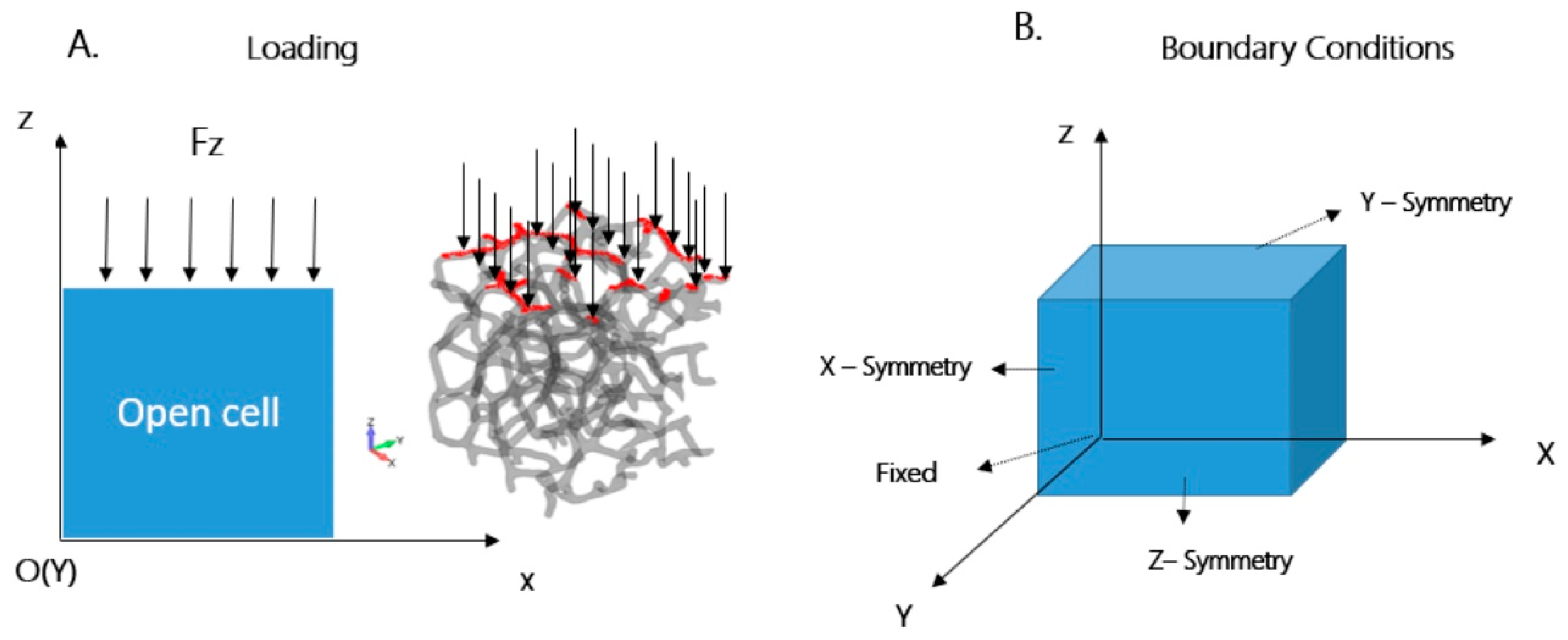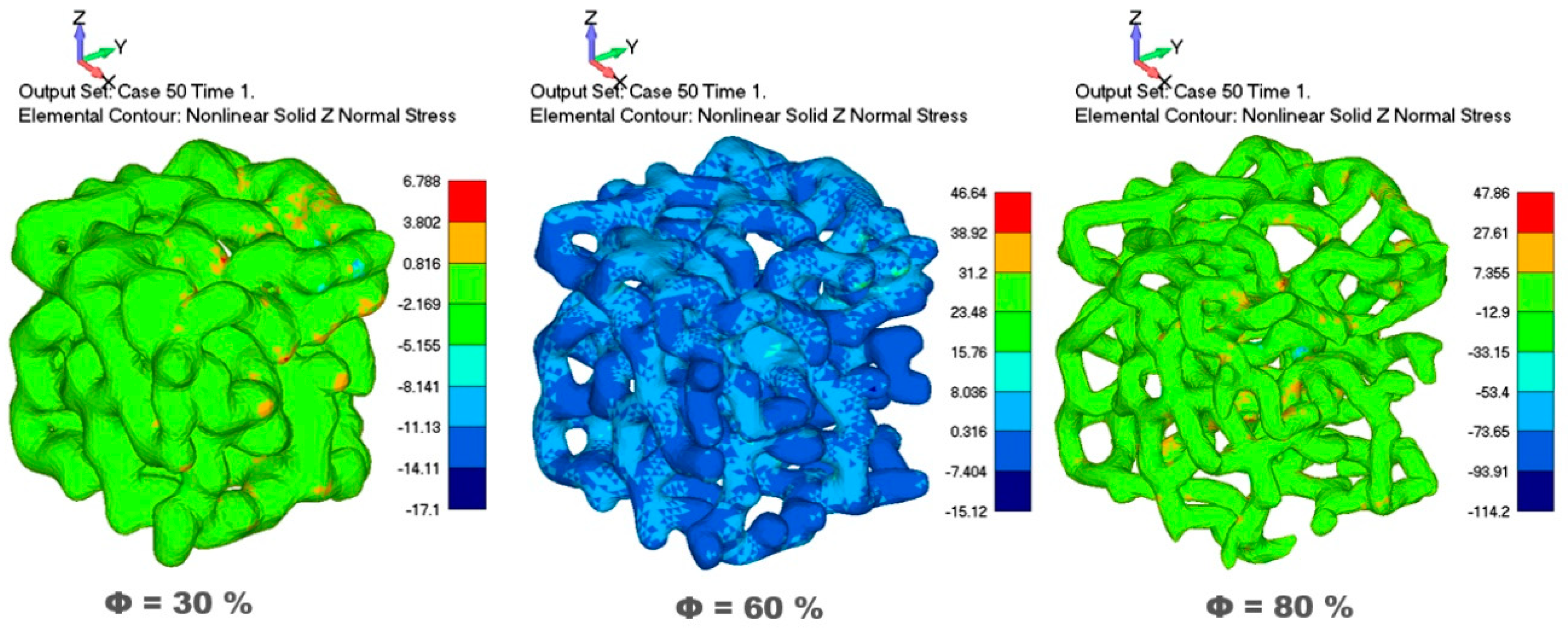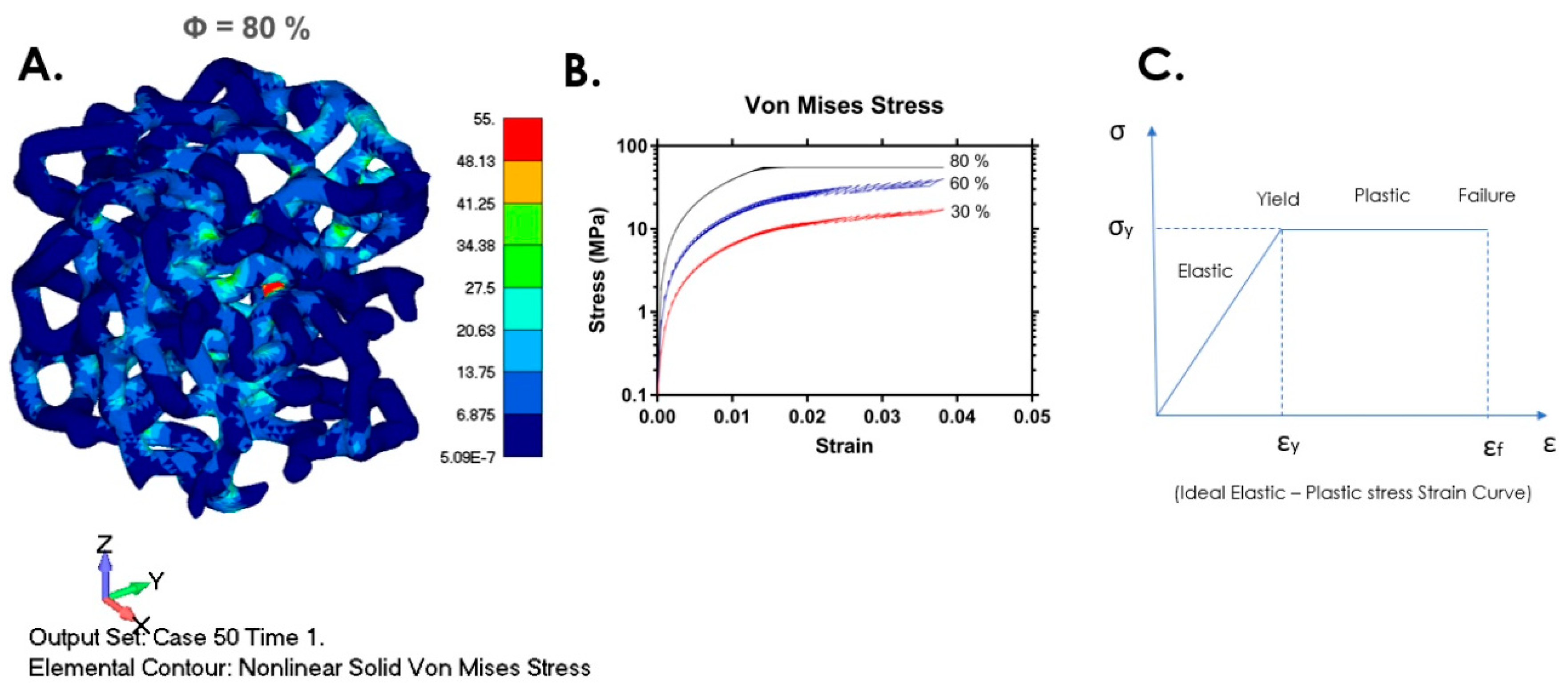Influence of Porosity on the Mechanical Behavior during Uniaxial Compressive Testing on Voronoi-Based Open-Cell Aluminium Foam
Abstract
:1. Introduction
2. Methodology and Assumptions
2.1. Voronoi Tessellation Method (VTM)-Based Open-Cell Model
2.2. Meshing
2.3. Nonlinear Modelling of Open-Cell Aluminium Foam
3. Results and Discussion
4. Conclusions
Author Contributions
Funding
Conflicts of Interest
References
- Rajak, D.; Kumaraswamidhas, L. Technical overview of aluminium alloy foam. Rev. Adv. Mater. Sci. 2017, 48, 68–86. [Google Scholar]
- Borovinek, M.; Taherishargh, M.; Vesenjak, M.; Ren, Z.; Fiedler, T. Geometrical characterization of perlite-metal syntactic foam. Mater. Charact. 2016, 119, 209–215. [Google Scholar] [CrossRef]
- Taherishargh, M.; Belova, I.; Murch, G.; Fiedler, T. The effect of particle shape on mechanical properties of perlite/metal syntactic foam. J. Alloys Compd. 2017, 693, 55–60. [Google Scholar] [CrossRef]
- Daoud, A. Effect of fly ash addition on the structure and compressive properties of 4032fly ash particle composite foams. J. Alloys Compd. 2009, 487, 618–625. [Google Scholar] [CrossRef]
- Solrzano, E.; Reglero, J.; Rodrguez-Prez, M.; Lehmhus, D.; Wichmann, M.; de Saja, J. An experimental study on the thermal conductivity of aluminium foams by using the transient plane source method. Int. J. Heat Mass Transf. 2008, 51, 6259–6267. [Google Scholar] [CrossRef]
- Jigh, B.H.G.; Toudeshky, H.H.; Farsi, M.A. Experimental and multi-scale analyses of open-celled aluminum foam with hole under compressive quasi-static loading. J. Alloy. Compd. 2017, 695, 133–141. [Google Scholar] [CrossRef]
- Linul, E.; Marsavina, L.; Kovik, J. Collapse mechanisms of metal foam matrix composites under static and dynamic loading conditions. Mater. Sci. Eng. A 2017, 690, 214–224. [Google Scholar] [CrossRef]
- Fischer, S.F. Energy absorption efficiency of open-cell pure aluminum foams. Mater. Lett. 2016, 184, 208–210. [Google Scholar] [CrossRef]
- Kraynik, A.M. Foam structure: From soap froth to solid foams. MRS Bull. 2003, 28, 275–278. [Google Scholar] [CrossRef]
- An, Y.; Yang, S.; Zhao, E.; Wang, Z. Fabrication and experimental investigation of metal grid structure-reinforced aluminum foams. Mater. Manuf. Process. 2018, 33, 528–533. [Google Scholar] [CrossRef]
- Banhart, J. Aluminium foams for lighter vehicles. Int. J. Veh. Des. 2005, 37, 114–125. [Google Scholar] [CrossRef]
- Schwingel, D.; Seeliger, H.-W.; Vecchionacci, C.; Alwes, D.; Dittrich, J. Aluminium foam sandwich structures for space applications. Acta Astronaut. 2007, 61, 326–330. [Google Scholar] [CrossRef]
- Xiao, Z.; Fang, J.; Sun, G.; Li, Q. Crashworthiness design for functionally graded foam-filled bumper beam. Adv. Eng. Softw. 2015, 85, 81–95. [Google Scholar] [CrossRef]
- Banhart, J. Manufacture, characterisation and application of cellular metals and metal foams. Prog. Mater. Sci. 2001, 46, 559–632. [Google Scholar] [CrossRef]
- Lin, H.; Luo, H.; Huang, W.; Zhang, X.; Yao, G. Diffusion bonding in fabrication of aluminum foam sandwich panels. J. Mater. Process. Technol. 2016, 230, 35–41. [Google Scholar] [CrossRef]
- Duarte, I.; Krstulovic-Opara, L.; Vesenjak, M. Characterisation of aluminium alloy tubes filled with aluminium alloy integral-skin foam under axial compressive loads. Compos. Struct. 2015, 121, 154–162. [Google Scholar] [CrossRef]
- Zu, G.; Song, B.; Zhong, Z.; Li, X.; Mu, Y.; Yao, G. Static three-point bending behavior of aluminum foam sandwich. J. Alloys Compd. 2012, 540, 275–278. [Google Scholar] [CrossRef]
- Hou, W.; Zhu, F.; Lu, G.; Fang, D.-N. Ballistic impact experiments of metallic sandwich panels with aluminium foam core. Int. J. Impact Eng. 2010, 37, 1045–1055. [Google Scholar] [CrossRef]
- Gupta, N.; Rohatgi, P.K. (Eds.) Metal Matrix Syntactic Foams: Processing, Microstructure, Properties and Applications; DEStech Publications Inc.: Lancaster, PA, USA, 2014. [Google Scholar]
- Orbulov, I.N.; Szlancsik, A. On the mechanical properties of aluminum matrix syntactic foams. Adv. Eng. Mater. 2018, 20, 1700980. [Google Scholar] [CrossRef]
- Du, Y.; Li, A.; Zhang, X.; Tan, Z.; Su, R.; Pu, F.; Geng, L. Enhancement of the mechanical strength of aluminum foams by sic nanoparticles. Mater. Lett. 2015, 148, 79–81. [Google Scholar] [CrossRef]
- Duarte, I.; Ventura, E.; Olhero, S.; Ferreira, J.M. A novel approach to prepare aluminium-alloy foams reinforced by carbon-nanotubes. Mater. Lett. 2015, 160, 162–166. [Google Scholar] [CrossRef]
- Szlancsik, A.; Katona, B.; Mjlinger, K.; Orbulov, I.N. Compressive behavior and microstructural characteristics of iron hollow sphere filled aluminum matrix syntactic foams. Materials 2015, 8, 7926–7937. [Google Scholar] [CrossRef]
- Mechanical Testing of Metals Ductility Testing Compression Test for Porous and Cellular Metals; ISO: Geneva, Switzerland, 2011.
- Linul, E.; Movahedi, N.; Marsavina, L. The temperature and anisotropy effect on compressive behavior of cylindrical closed-cell aluminum-alloy foams. J. Alloy. Compd. 2018, 740, 1172–1179. [Google Scholar] [CrossRef]
- Omar, M.Y.; Xiang, C.; Gupta, N.; Strbik, O.M.; Cho, K. Data characterizing flexural properties of al/al2o3 syntactic foam core metal matrix sandwich. Adv. Eng. Mater. 2015, 5, 564–571. [Google Scholar]
- Omar, M.; Xiang, C.; Gupta, N.; Strbik, O.; Cho, K. Syntactic foam core metal matrix sandwich composite under bending conditions. Mater. Des. 2015, 86, 536–544. [Google Scholar] [CrossRef] [Green Version]
- Andrews, E.; Sanders, W.; Gibson, L. Compressive and tensile behaviour of aluminum foams. Mater. Sci. Eng. A 1999, 270, 113–124. [Google Scholar] [CrossRef]
- Cadena, J.; Alfonso, I.; Ramrez, J.; Rodrguez-Iglesias, V.; Figueroa, I.; Aguilar, C. Improvement of fea estimations for compression behavior of mg foams based on experimental observations. Comput. Mater. Sci. 2014, 91, 359–363. [Google Scholar] [CrossRef]
- Li, Z.; Xi, C.; Jing, L.; Wang, Z.; Zhao, L. Effect of loading rate on the compressive properties of open-cell metal foams. Mater. Sci. Eng. A 2014, 592, 221–229. [Google Scholar] [CrossRef]
- Darvizeh, R.; Davey, K. Non-physical finite element modelling of high speed normal crushing of cellular materials. Int. J. Impact Eng. 2015, 82, 130–143. [Google Scholar] [CrossRef]
- Nair, A.; Mason, B.; Groven, L.; Son, S.; Strachan, A.; Cuitio, A. Micro-rve modeling of mechanistic response in porous intermetallics subject to weak and moderate impact loading. Int. J. Plast. 2013, 51, 1–32. [Google Scholar] [CrossRef]
- Ramrez, J.; Cardona, M.; Velez, J.; Mariaka, I.; Isaza, J.; Mendoza, E.; Betancourt, S.; Fernndez-Morales, P. Numerical modeling and simulation of uniaxial compression of aluminum foams using fem and 3d-ct images. Procedia Mater. Sci. 2014, 4, 227–231. [Google Scholar] [CrossRef]
- Wejrzanowski, T.; Skibinski, J.; Szumbarski, J.; Kurzydlowski, K. Structure of foams modeled by laguerrevoronoi tessellations. Comput. Mater. Sci. 2013, 67, 216–221. [Google Scholar] [CrossRef]
- Sotomayor, O.E.; Tippur, H.V. Role of cell regularity and relative density on elasto-plastic compression response of 3-D open-cell foam core sandwich structure generated using Voronoi diagrams. Acta Mater. 2014, 78, 301–313. [Google Scholar] [CrossRef]
- Schladitz, K.; Redenbach, C.; Sych, T.; Godehardt, M. Model based estimation of geometric characteristics of open foams. Methodol. Comput. Appl. Probab. 2012, 14, 1011–1032. [Google Scholar] [CrossRef]
- Kraynik, A. The structure of random foam. Adv. Eng. Mater. 2006, 8, 900–906. [Google Scholar] [CrossRef]
- Hitti, K.; Laure, P.; Coupez, T.; Silva, L.; Bernacki, M. Precise generation of complex statistical representative volume elements (rves) in a finite element context. Comput. Mater. Sci. 2012, 61, 224–238. [Google Scholar] [CrossRef]
- Ghosh, S.; Moorthy, S. Three dimensional voronoi cell finite element model for microstructures with ellipsoidal heterogeneities. Comput. Mech. 2004, 34, 510–534. [Google Scholar] [CrossRef]
- Zhou, J.; Shrotriya, P.; Soboyejo, W.O. Mechanisms and mechanics of compressive deformation in open-cell Al foams. Mech. Mater. 2004, 36, 781–797. [Google Scholar] [CrossRef]
- Shunmugasamy, V.C.; Mansoor, B. Compressive behavior of a rolled open-cell aluminum foam. Mater. Sci. Eng. A 2018, 715, 281–294. [Google Scholar] [CrossRef]
- Deshpande, V.S.; Fleck, N.A. High strain rate compressive behaviour of aluminium alloy foams. Int. J. Impact Eng. 2000, 24, 277–298. [Google Scholar] [CrossRef] [Green Version]
- Jang, W.-Y.; Kyriakides, S.; Kraynik, A.M. On the compressive strength of open-cell metal foams with Kelvin and random cell structures. Int. J. Solids Struct. 2010, 47, 2872–2883. [Google Scholar] [CrossRef] [Green Version]
- Sullivan, R.M.; Ghosn, L.J.; Lerch, B.A. A general tetrakaidecahedron model for open-celled foams. Int. J. Solids Struct. 2008, 45, 1754–1765. [Google Scholar] [CrossRef] [Green Version]
- Jang, W.-Y.; Kyriakides, S. On the crushing of aluminum open-cell foams: Part II analysis. Int. J. Solids Struct. 2009, 46, 635–650. [Google Scholar] [CrossRef] [Green Version]





| Porosity | Internal Matrix Size Given for Voronoi Code (mm) | Strut Length (mm) | Void Diameter (mm) |
|---|---|---|---|
| 30% | 0.6–0.7 | 1–1.5 | ≈0.5 |
| 60% | 0.4–0.5 | 0.75–1 | ≈1.0 |
| 80% | 0.25–30 | 0.5–0.75 | ≈1.5 |
| Porosity | Number of Tetrahedral 10 Node Elements |
|---|---|
| 30% | 152364 |
| 60% | 177484 |
| 80% | 128673 |
| Density (Tonne/mm3) | Young Modulus of Elasticity (MPa) | Poisson Ratio | Yield Stress (MPa) |
|---|---|---|---|
| 2.7 × 10−9 | 68200 | 0.3 | 55 |
| Cartesian Coordinate Axes | Degree of Freedom | |||||
|---|---|---|---|---|---|---|
| Translational in x Directions | Translational in y Directions | Translational in z Directions | Rotational in x Directions | Rotational in y Directions | Rotational in z Directions | |
| x–Symmetry | ✓ | ✓ | ✓ | |||
| y–Symmetry | ✓ | ✓ | ✓ | |||
| z–Symmetry | ✓ | ✓ | ✓ | |||
| Fixed Node | ✓ | ✓ | ✓ | ✓ | ✓ | ✓ |
© 2019 by the authors. Licensee MDPI, Basel, Switzerland. This article is an open access article distributed under the terms and conditions of the Creative Commons Attribution (CC BY) license (http://creativecommons.org/licenses/by/4.0/).
Share and Cite
Sharma, V.; Grujovic, N.; Zivic, F.; Slavkovic, V. Influence of Porosity on the Mechanical Behavior during Uniaxial Compressive Testing on Voronoi-Based Open-Cell Aluminium Foam. Materials 2019, 12, 1041. https://doi.org/10.3390/ma12071041
Sharma V, Grujovic N, Zivic F, Slavkovic V. Influence of Porosity on the Mechanical Behavior during Uniaxial Compressive Testing on Voronoi-Based Open-Cell Aluminium Foam. Materials. 2019; 12(7):1041. https://doi.org/10.3390/ma12071041
Chicago/Turabian StyleSharma, Varun, Nenad Grujovic, Fatima Zivic, and Vukasin Slavkovic. 2019. "Influence of Porosity on the Mechanical Behavior during Uniaxial Compressive Testing on Voronoi-Based Open-Cell Aluminium Foam" Materials 12, no. 7: 1041. https://doi.org/10.3390/ma12071041
APA StyleSharma, V., Grujovic, N., Zivic, F., & Slavkovic, V. (2019). Influence of Porosity on the Mechanical Behavior during Uniaxial Compressive Testing on Voronoi-Based Open-Cell Aluminium Foam. Materials, 12(7), 1041. https://doi.org/10.3390/ma12071041






